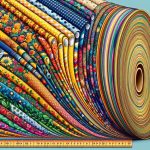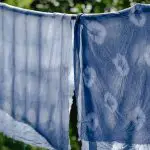Do you know that an average person spends over 5,000 hours of their life deciding how much fabric to buy for a project?
In 'How Much Fabric Do I Need? A Handy Guide,' you'll master the art of calculating fabric yardage like a pro.
This guide will walk you through measuring, factoring in pattern repeats, and adjusting for different fabric types and widths.
You'll gain the confidence to buy just the right amount of fabric for your next sewing or upholstery project.
Let's dive in and make those fabric shopping decisions a breeze!
Key Takeaways
- Accurately calculate fabric yardage by measuring the length and width of pattern pieces.
- Consider the weight and texture of the fabric for yardage estimation.
- Fabrics with a nap or directional pattern may require extra yardage for pattern matching.
- Consult the pattern for specific yardage requirements based on fabric width and weight.
Understanding Fabric Yardage
To accurately calculate fabric yardage, you'll need to measure the length and width of your pattern pieces and then add extra for seam allowances and pattern matching. When it comes to calculating yardage, understanding the fabric weight is crucial. Heavier fabrics like denim or wool will require more yardage than lighter ones such as silk or chiffon. The texture of the fabric also plays a role in yardage estimation. For fabrics with a nap or directional pattern, you may need extra yardage to ensure pattern matching.
When estimating yardage, it's important to consider the width of the fabric as well. Most standard fabrics come in 45-inch or 60-inch widths, and wider fabrics will require less yardage than narrower ones. It's recommended to consult the pattern you're using for specific yardage requirements, as patterns often provide guidance based on the fabric width and weight.
Understanding fabric yardage is essential for any sewing or crafting project. It ensures that you purchase the right amount of fabric, preventing any last-minute trips to the store and allowing you to fully focus on your creative process.
Measuring and Calculating for Your Project
Measure the length and width of your pattern pieces with precision to accurately calculate the fabric yardage needed for your project. Calculating dimensions is crucial for estimating yardage.
Once you have your pattern pieces ready, use a tape measure to determine the length and width of each piece. Round up your measurements to the nearest quarter inch for accuracy. Take note of any pattern pieces that need to be cut on the bias or have a one-way design, as these may require additional fabric.
After measuring, refer to your pattern's fabric yardage requirements. Patterns usually provide yardage estimates based on the width of the fabric. If your fabric is a different width than the one specified on the pattern, you may need to adjust the yardage accordingly. Additionally, consider any pattern matching or directional prints, which may increase the yardage needed.
Once you have calculated the total yardage needed for each pattern piece, add them together to determine the overall fabric yardage required for your project. It's always a good idea to purchase a bit of extra fabric to accommodate any unforeseen adjustments or mistakes.
Factoring in Pattern Repeats and Directional Prints
How do you account for pattern repeats and directional prints when calculating fabric yardage for your project? When working with patterned fabric, it's essential to consider pattern repeats and directional prints to ensure you have enough fabric and that the pattern is correctly aligned. Let's break it down:
| Consideration | Description | Example |
|---|---|---|
| Pattern Repeats | Pattern repeats refer to the vertical and horizontal distance before the pattern begins again. It's crucial to factor in the full pattern repeat when calculating fabric needed. | If a fabric has a 12-inch vertical repeat, ensure your pattern pieces are spaced by at least 12 inches to match the design seamlessly. |
| Fabric Placement | Understanding the fabric pattern's placement is vital. Consider how the pattern will flow across your project and adjust yardage calculations accordingly. | For a symmetrical design, you might need extra fabric to ensure the pattern aligns correctly on all pieces. |
| Directional Prints | Fabrics with directional prints, like stripes or one-way designs, require careful attention to ensure the pattern runs uniformly in the desired direction. | When cutting directional prints, you may need more fabric to accommodate for a specific cutting layout that maintains the print's direction. |
Taking these factors into account will ensure that your patterned fabric is used efficiently, with the design flowing seamlessly across your project.
Adjusting for Fabric Width and Type
When considering fabric width and type, you should account for the differences in available widths and the characteristics of different fabric types to accurately calculate the yardage required for your project.
Here are some key points to consider when adjusting for fabric width and type:
- Adjusting Width: Take into account the width of the fabric you plan to use for your project. Standard fabric bolts come in varying widths, commonly 45 inches and 60 inches, but specialty fabrics may differ. Adjust your yardage calculation based on the width of the fabric you intend to use.
- Fabric Type: Different fabric types have unique characteristics that can affect yardage calculation. For instance, fabrics with a nap, such as velvet or corduroy, may require additional yardage to ensure all pattern pieces can be cut in the same direction. Similarly, sheer fabrics might need to be doubled or lined, impacting the total yardage needed.
- Yardage Calculation: Understanding how different fabric types and widths affect yardage requirements is essential for accurate project planning. Be sure to adjust your yardage calculation based on the specific fabric type and width you'll be working with.
Understanding and adjusting for fabric width and type will ensure that you have the right amount of fabric for your project, saving you from potential errors and fabric wastage.
Tips for Buying the Right Amount
To ensure you purchase the correct amount of fabric for your project, there are several factors to consider.
- Start by estimating yardage based on your pattern's recommendations. Take into account any adjustments for fabric width and type.
- It's essential to consider fabric wastage, especially when working with patterns that have a lot of pieces or intricate designs.
- When buying fabric online, be sure to check the fabric's width and calculate the cost per yard to make an accurate purchase.
- Keep in mind that some fabrics have a nap or a one-way design, requiring additional yardage for proper pattern placement.
- If you're unsure about the amount you need, it's always better to buy a little extra to avoid running short.
- Additionally, consider the fabric's intended use. Upholstery, for example, may require more fabric than a simple garment.
Frequently Asked Questions
Can I Use Different Types of Fabric for the Same Project, and if So, How Do I Calculate the Yardage Needed for Each Type?
You can definitely use different types of fabric for the same project, giving it unique flair. When calculating yardage for each type, simply add up the yardage needed for each fabric and make sure to account for any pattern or directionality.
What Should I Do if the Fabric I Want to Use Has a Specific Pattern or Directional Print That I Want to Match Up?
When matching patterns or directional prints, carefully select your fabric. Pay attention to pattern alignment and the direction of the print. Take your time to ensure a cohesive look in your project.
Is There a Way to Estimate Fabric Yardage Without Using a Measuring Tape or Ruler?
Estimating yardage without a measuring tool is possible using visual estimation. If you're substituting fabric or matching patterns, it's helpful to lay out pieces side by side. This technique aids in determining the necessary yardage.
How Do I Account for Fabric Shrinkage When Calculating Yardage for a Project?
When calculating shrinkage, always adjust your yardage calculations. Factor in the potential shrinkage percentage provided on the fabric label. It's crucial to account for this to ensure you have enough fabric for your project.
Are There Any Common Mistakes People Make When Estimating Fabric Yardage for a Project, and How Can I Avoid Them?
When estimating fabric yardage, common mistakes include not accounting for shrinkage, failing to match patterns, and not considering fabric alternatives. Avoid these by factoring in shrinkage, carefully matching patterns, and exploring different fabric options.
- The Use of Nonwovens in Construction and Civil Engineering - July 11, 2025
- The Use of Nonwovens in Construction and Civil Engineering - July 11, 2025
- The Use of Nonwovens in Construction and Civil Engineering - July 11, 2025







